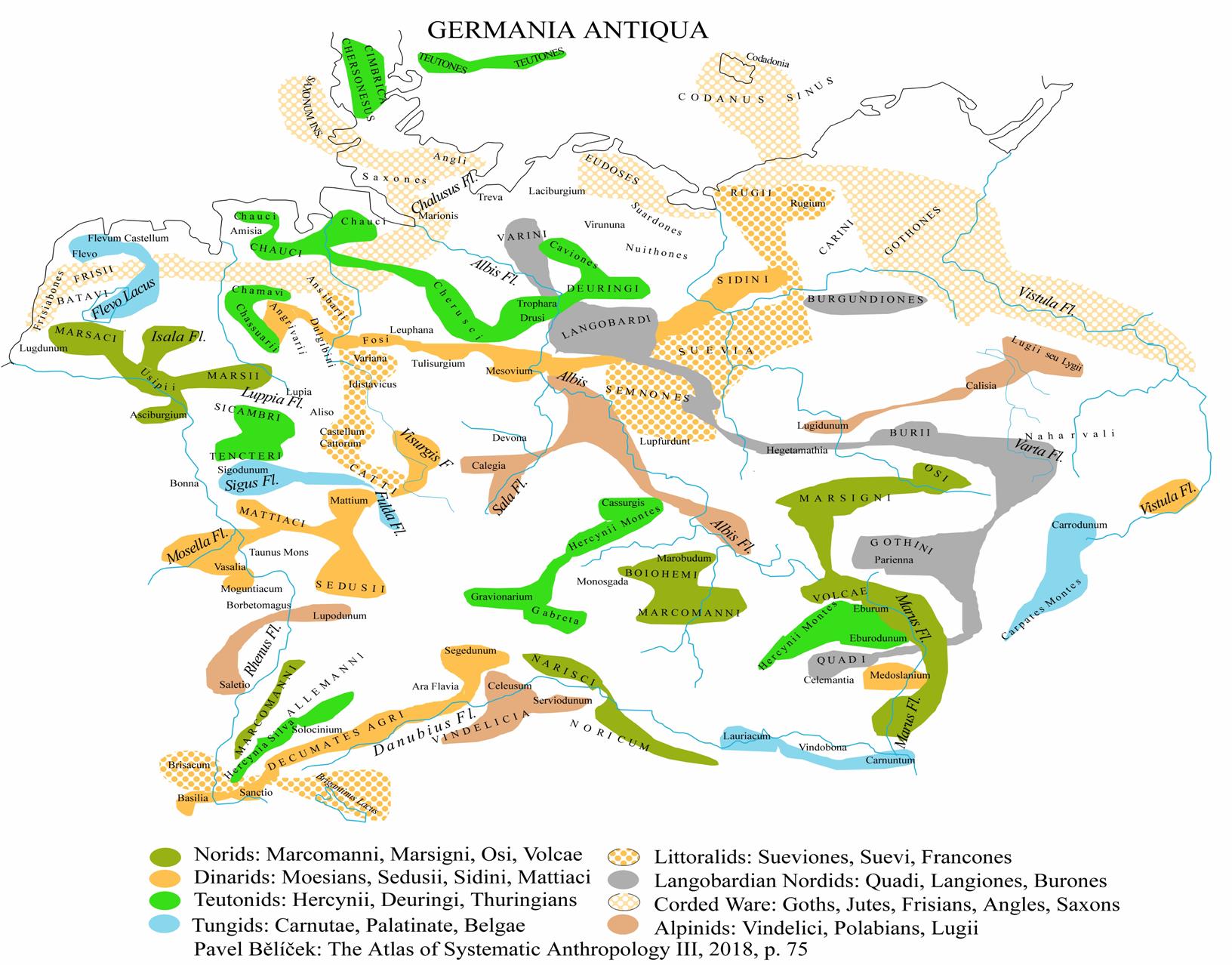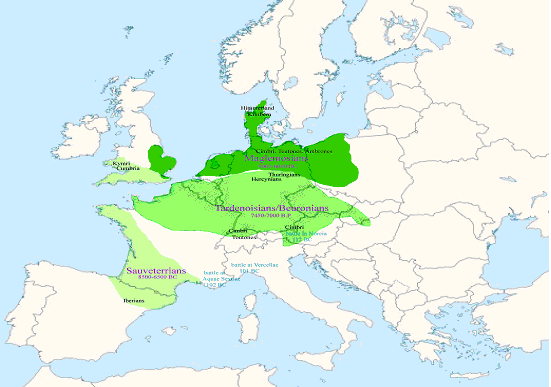|
|
|
|||||||||||||||||||||||||||||||||||||||||||||||||||||||||||||||||||||||||||||
|
|
|
|||||||||||||||||||||||||||||||||||||||||||||||||||||||||||||||||||||||||||||
|
|
|
|
||||||||||||||||||||||||||||||||||||||||||||||||||||||||||||||||||||||||||||
|
|
|
|
||||||||||||||||||||||||||||||||||||||||||||||||||||||||||||||||||||||||||||
|
|
|
|
||||||||||||||||||||||||||||||||||||||||||||||||||||||||||||||||||||||||||||
|
|
|
|||||||||||||||||||||||||||||||||||||||||||||||||||||||||||||||||||||||||||||
|
|
|
|
||||||||||||||||||||||||||||||||||||||||||||||||||||||||||||||||||||||||||||
|
|
|
|
|
|||||||||||||||||||||||||||||||||||||||||||||||||||||||||||||||||||||||||||
|
|
The
Ancient Races of Germania Clickable terms are red on yellow background |
|
|
|||||||||||||||||||||||||||||||||||||||||||||||||||||||||||||||||||||||||||
|
The tribes and
races of ancient Germania (from P. Bělíček: The
Analytic Survey of European Anthropology, Prague 2018, Map 16, p. 75) |
||||||||||||||||||||||||||||||||||||||||||||||||||||||||||||||||||||||||||||||
|
|
Germanic genealogies have to be revisited
from the archaeological point of view. Germanic ancestors came to western
Europe from the east with three Microlithic
cultures. The northern stream was represented by Maglemosians (c. 9000-6000 BC) and the central Hercynian
stream was conducted by the Beuronians or Tardenoisians (7450-7000 BP). The southern Danubian stream
was of earlier origin, its first pioneers were Magdalenians
(17,000 BP), who specialised as reindeer hunters. Their territories were
later occupied by two affiliated groups of microlithic
flake tool assemblages, at first the Azilians (14,000-10,000
BP) and then the Sauveterrians
(8500-6500 BC). What united these
filial cultures and waves of migrations into one group was a similar
composition of tribal phratries. Their migration
tracks seemed to multiply the basic five of ethnonyms
alluding to the phratries of Cimbrians,
Teutons, Turanids,
Germans and Casites (Table 17). Such paradigm of ethnonymic associations was roughly applicable also to microlithic sites in
Map 15. Cimbrian settlements after Maglemosian, Beuronian and Sauveterrian colonisations The
Taxonomic Disambiguation of the Germanic Peoples
The major crux in
Germanic philology is the ethnic identity of Germans, who are classified as
one of Indo-European families but exhibit many heterogeneous cultural traits.
According to Tacit’s genealogies, Germans descended
from Tuisto, his son Mannus
and three grandsons Irmin, Istvo
and Ingvo: “the God Tuisto sprang from the earth, … he and his son Mannus were the founders of the race. To Mannus they ascribe three sons, whose names are borne
respectively by the Ingæuones next to
the ocean, the Herminones in the middle of
the country, and the Istæuones
in the rest of it.”1 Modern
philology prefers to spell Ingæuones as Ingaevones and Istæuones as Istvaeones. Jacob
Grimm2
anticipated modern interpretations by identifying the Ingaevones
with the Saxons, the Istvaeones with
the Franks, and the Herminones with the
Thuringians.3 His conclusions were
further developed by Friedrich Maurer4, who identified Germanic tribes with Herminonen and divided them into subfamilies of Teutonen, Istväonen, Ingväonen and Illevionen. Tacit was aware that contemporary Germanic
populations included heterogeneous ethnic enclaves that defended their own
claims to Tuisto’s heirdom:
“Others, with true mythological license, give the deity several more sons,
from whom are derived more tribal names, such as Marsians,
Gambrivians, Suabians,
and Vandals; and these names are both genuine and ancient.”5 They
reflected the state of many disconnected chieftaincies competing for hegemony
in the Fallacies of royal genealogies.
Another account of Germanic genealogies was given by Pliny the Elder in his Naturalis historia. In his view the Herminones
and Hermunduri descended from the
same line of descent as Mannus. Their stock
encompassed also the tribes of Chatti, Cherusci, and Suebi.7 Jacob Grim derived the origin of Istvaeones from a
hero Ask featuring in Norse mythology. He mentioned passages from Historia Brittonum by Nennius, where
a certain Escio was counted as an ancestor of the Istvaeones. In our view such genealogies evolved from
royal catalogues of ruling dynasties that were composed as an assemblage of
several incoherent pantheons. Their purpose was to subordinate the deities of
subjugated ethnicities to the supreme god of the reigning clan. This
deception was construed by adopting them as step-sons into the family of
their earliest ancestor celebrated as the supreme divinity. In ancient Germanic genealogies have to
be revisited from the archaeological point of view. Germanic ancestors came
to western Europe from the east with three Microlithic
cultures. The northern stream was represented by Maglemosians (c. 9000-6000 BC) and the central Hercynian
stream was conducted by the Beuronians or Tardenoisians (7450-7000
BP). The southern Danubian stream was of earlier
origin, its first pioneers were Magdalenians (17,000 BP), who specialised
as reindeer hunters. Their territories were later occupied by two affiliated
groups of microlithic flake tool assemblages, at
first the Azilians (14,000-10,000 BP) and then the Sauveterrians
(8500-6500 BC). What united these
filial cultures and waves of migrations into one group was a similar
composition of tribal phratries. Their migration
tracks seemed to multiply the basic five of ethnonyms
alluding to the phratries of Cimbrians,
Teutons, Turanids,
Germans and Casites (Table 17). Such paradigm of ethnonymic associations was roughly applicable also to microlithic sites in The
Ethnic Substrates of Germanic Dialectology
The German linguist Friedrich Maurer took Tacit’s
legend about Tuisto and combined it with Pliny’s
reports about Mannus and [H]illeviones.1 Their synthesis resulted in a
widely-accepted classification of Germanic languages and dialects.2 It counted with the mythic tripartition splitting Germanic nations into Istvaeonic and Ingvaeonic
and Irminonic tribes but included also a less
reliably evidenced branch of Illeviones. His Irminones encompassed the Elbe Germanic group
headed by Thuringians, Bavarians and Alamanni. The core of Ingvaeones was formed by the North
Sea Germanic people, who consisted of Frisians, Angles and Saxons. The
subgroup of Istvaeones provided a convenient label for the Weser-Rhine Germanic branch uniting chiefly Franks and Chatti (Graph 1). His considerations built a passable
bridge between ancient Latin historiography and modern Germanic philology
inclusive of dialectology.
Graph 1.
Friedrich Maurer’s subcategorisation of Germanic language
families Maurer’s
contributions influenced Germanic dialectology but suffered from classical
preconceptions of Germanic historical grammar. His elucidation
of Germanic languages consisted of one-sided misinterpretations of Germanic
myths grafted on a sound rational partitioning of dialectal groupings. The
second prominent founder of Germanic dialectology appeared in Ferdinand Wrede1, who elaborated the Irminonic theory of Elbe Germanic dialects to perfection.
Their followers added several substantial refinements.2 They realised that the Ingaeonic covered the block of Goths, Jutes and Frisians
inclusive of Dutch, Jutlandic and Low German. The Istvaeonic subfamily was dubbed as Weser-Rhein-Germanisch
and its domain covered the Franconian family
with West Central German dialects. Illeviones
were posed as a hypothetical group covering Silesians and Oder-Vistula
subfamily. Fruitful results were brought especially by the popular theory of Ingvaeonisms in Germanic dialects. It developed
theoretical considerations on the Ingvaeonic origin
of Anglo-Saxons.3 The fallacy of prehistoric
nations. Maurer’s errors require a digression to contrasts between the
ancient and modern concept of a tribe. Modern authors suffer from an irresistible inclination to conceive
prehistoric tribes as large united compact nations coextensive with the
present-day republics. They are liable to discard all indications of inner
ethnic plurality and deny all long-range links between continental tribes. In
opposition to their biased views, the ancients acknowledged the surviving
state of diversity and saw genetic consanguinity between remote related
cognates. Their geographers did not mind linking different Eurasian factions
of Scythians, Sarmatians, Kimmerians,
Pelasgians or Hyperboreans.
They confirmed immense geographical diversity and scattered distribution of
ethnic groups. The ancient world did not see any compact nations and
homogeneous countries without a rich internal stratification of castes,
classes, enclaves and minorities. In their eyes ancients Jutlandic
and Subalpine Cimbri
were related to the Kimmerioi4
on the |
|
Archaeological Roots of Germanic Minorities
Turanids. Mesolithic cultures with microlith implements drifted from
Table
20. The
varieties of European Turcoids,
Cimbrids, Germanics and Punoids
The Germanic newcomers were Epi-Maglemosian
‘bog-people’, who inherited the Y-DNA haplogroup
R1a-M420. They went fishing in boats and used canoes as coffins for burials
of their dead. Their Madgalenian relatives in
Table 21. The
comparative ethnonymy
of Turanids and Turcoid
tribes Cimbroid cultures
exhibited features characteristic of peoples producing Epi-Magdalenian,
Epi-Azilian and Epi-Tardenoisian
microlithic tools. Their descendants are usually
mentioned in historical annals as Celtiberians, Eburones, Eburovices,
Etruscans, Irish Iverni or Hiberni. Their life-style differed a lot
from Punids, who were renowned as maritime
fishermen and pirates. They lived in cliff-dwellings that were hewn in
coastal crags and accessed through vertical shafts. One of their branches was
formed by Phoenicians who specialised in seafaring. The ancients believed
that they came to the Prehistoric Germanic tribes
were associated with Gotho-Frisian Nordids only by contact vicinity and integrated into
European phenotypes as Mediterranids or Subnordids. More influential impact was perceptible in
the constitution of Romance, Italic, Slavonic and Baltic languages families.
They descended from Gravettian and Lusatian colonisations that took their course as peaceful
infiltrations. They inoculated the Gothonic core of
Indo-European and differentiated from its standard by importing nasal vowels,
satem shifts, palatal stops and affricates.
Traditional doctrines classify them as brachycephalous
Subnordids and describe their tongues as genuine
Indo-European languages. Their structural import consisted in numerous
innovative additions such as masculine o-stems and feminine a-stems.
They contrasted with the inflective morphology of Anatolian
Proto-Indo-Europeans, who distinguished only animate and inanimate gender and
recognised only neutral i-stems with
nominative s-plurals. Extract from Pavel
Bělíček: The Analytic Survey of European
Anthropology, Prague 2018, pp.
145-86. |
|
||||||||||||||||||||||||||||||||||||||||||||||||||||||||||||||||||||||||||
1 Tacit, Germ. 2.
2 Jacob Grimm: Deutsche Mythologie Göttingen, 1835.
3 William
Stubbs: Constitutional History of England, I, 1880, p. 38.
4 Friedrich Maurer: Nordgermanen und Alemannen:
Studien zur germanischen und frühdeutschen
Sprach-geschichte, Stammes-
und Volkskunde.
5 Tacit, Germ. 2.
6 Plinius, Naturalis historia
37, 35; Ptolemaeus 2, 11, 9.
7 Plinius, Naturalis historia 4, 100.
1 Plinius, Naturalis historia
I, 1.
2 Friedrich Maurer: Nordgermanen und Alemannen: Studien
zur germanischen und frühdeutschen Sprach-geschichte, Stammes- und
Volkskunde. Bern: A. Francke, 1952, pp. 175-178.
1 Ferdinand Wrede: Ingwäonisch und
Westgermanisch. Zeitschrift für deutsche Mundarten, 1924: 270-283; V. M.
Zhirmunski: Deutsche Mundartkunde. Berlin 1962.
2 Carol Henriksen – Johan van der Auwera: 1. The Germanic
Languages. In: Johan van der Auwera, ed. The Germanic Languages.
London, New York: Routledge, 1994, 2013, pp. 1-18. p. 9.
3 Ferdinand Wrede: Ingwäonisch und
Westgermanisch. Zeitschrift für deutsche Mundarten, 1924: 270-283; T.
Frings: Grundlegung einer Geschichte der deutschen Sprache. Halle 1957.;
V.
M. Zhirmunski: Deutsche Mundartkunde. Berlin 1962, p. 50-51.
4 Strabo, Geography 7.2.2; Diodorus
Siculus, Bibl.5.32.4; Plutarch, Vit.Mar. 11.11.



